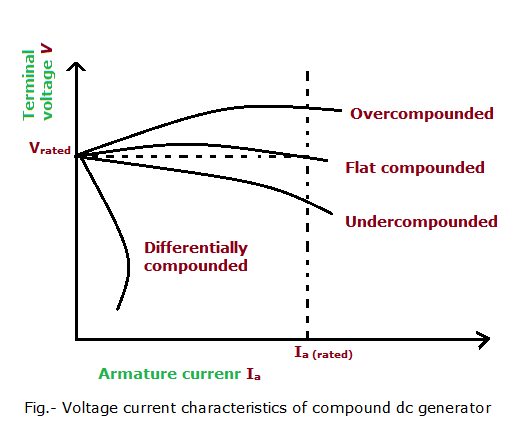Characteristics of a shunt generator
We have seen in the previous section
that one needs a separate d.c supply to generate d.c voltage. Is it possible to
generate d.c voltage without using another d.c source? The answer is yes and
for obvious reason such a generator is called self excited generator.
Field coil (F1, F2) along with a series
external resistance is connected in parallel with the armature terminals (A1,
A2) of the machine as shown in figure (38.5). Let us first qualitatively
explain how such connection can produce sufficient voltage. Suppose there
exists some residual field. Therefore, if the generator is driven at rated
speed, we should expect a small voltage (k nφres ) to be induced
across the armature. But this small voltage will be directly applied across the
field circuit since it is connected in parallel with the armature. Hence a
small field current flows producing additional flux. If it so happens that this
additional flux aids the already existing residual flux, total flux now becomes
more generating more voltage. This more voltage will drive more field current
generating more voltage. Both field current and armature generated voltage grow
cumulatively.
This growth of voltage and the final value to which it will settle down can be understood by referring to (38.6) where two plots have been shown. One corresponds to the O.C.C at rated speed and obtained by connecting the generator in separately excited fashion as detailed in the preceding section. The other one is the V-I characteristic of the field circuit which is a straight line passing through origin and its slope represents the total field circuit resistance.

Initially voltage induced due to residual flux
is obtained from O.C.C and given by Od. The field current thus produced can be
obtained from field circuit resistance line and given by Op. In this way
voltage build up process continues along the stair case. The final stable
operating point (M) will be the point of intersection between the O.C.C and the
field resistance line. If field circuit resistance is increased, final voltage
decreases as point of intersection shifts toward left. The field circuit
resistance line which is tangential to the O.C.C is called the critical
field resistance. If the field circuit resistance is more than the critical
value, the machine will fail to excite and no voltage will be induced - refer
to figure 38.7. The reason being no point of intersection is possible in this
case.
Suppose a shunt generator has built up voltage at a certain speed. Now if the speed of the prime mover is reduced without changing Rf, the developed voltage will be less as because the O.C.C at lower speed will come down (refer to figure 38.8). If speed is further reduced to a certain critical speed (ncr), the present field resistance line will become tangential to the O.C.C at ncr. For any speed below ncr, no voltage built up is possible in a shunt generator.

The machine must have some residual
field. To ensure this one can at the beginning excite the field separately with
some constant current. Now removal of this current will leave some amount of
residual field.
Field winding connection should
be such that the residual flux is strengthened by the field current in the
coil. If due to this, no voltage is being built up, reverse the field terminal
connection.
Total field circuit resistance
must be less than the critical field resistance.
Related Articles
Lesson meta keywords and meta description:
Write a public review